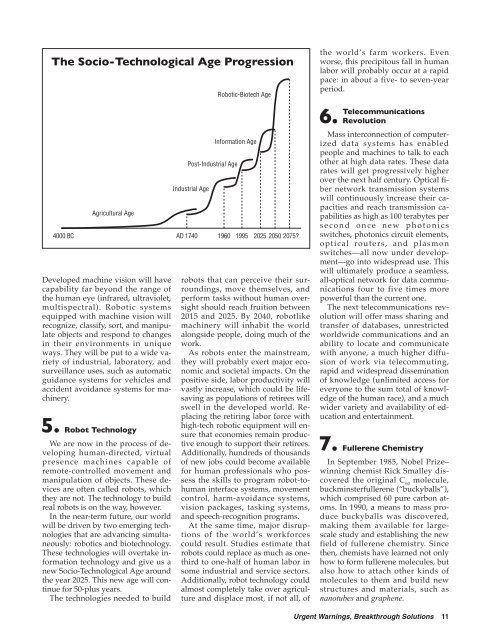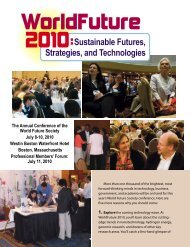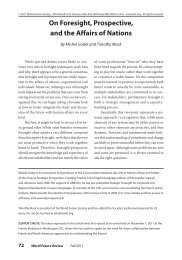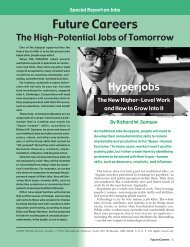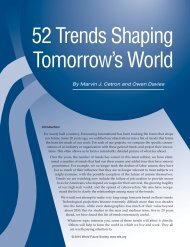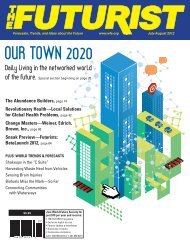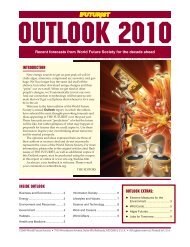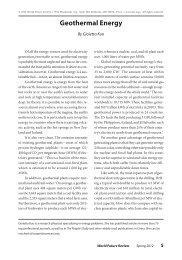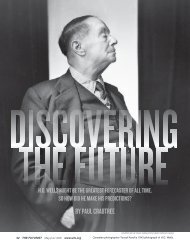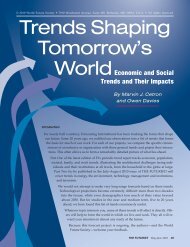Urgent Warnings, Breakthrough Solutions, Second Edition
Urgent Warnings, Breakthrough Solutions, Second Edition
Urgent Warnings, Breakthrough Solutions, Second Edition
Create successful ePaper yourself
Turn your PDF publications into a flip-book with our unique Google optimized e-Paper software.
The Socio-Technological Age Progression<br />
Agricultural Age<br />
Developed machine vision will have<br />
capability far beyond the range of<br />
the human eye (infrared, ultraviolet,<br />
multispectral). Robotic systems<br />
equipped with machine vision will<br />
recognize, classify, sort, and manipulate<br />
objects and respond to changes<br />
in their environments in unique<br />
ways. They will be put to a wide variety<br />
of industrial, laboratory, and<br />
surveillance uses, such as automatic<br />
guidance systems for vehicles and<br />
accident avoidance systems for machinery.<br />
5. Robot Technology<br />
We are now in the process of developing<br />
human-directed, virtual<br />
presence machines capable of<br />
remote-controlled movement and<br />
manipulation of objects. These devices<br />
are often called robots, which<br />
they are not. The technology to build<br />
real robots is on the way, however.<br />
In the near-term future, our world<br />
will be driven by two emerging technologies<br />
that are advancing simultaneously:<br />
robotics and biotechnology.<br />
These technologies will overtake information<br />
technology and give us a<br />
new Socio-Technological Age around<br />
the year 2025. This new age will continue<br />
for 50-plus years.<br />
The technologies needed to build<br />
Robotic-Biotech Age<br />
Information Age<br />
Post-Industrial Age<br />
Industrial Age<br />
4000 BC AD 1740 1960 1995 2025 2050 2075?<br />
robots that can perceive their surroundings,<br />
move themselves, and<br />
perform tasks without human oversight<br />
should reach fruition between<br />
2015 and 2025. By 2040, robotlike<br />
machinery will inhabit the world<br />
alongside people, doing much of the<br />
work.<br />
As robots enter the mainstream,<br />
they will probably exert major economic<br />
and societal impacts. On the<br />
positive side, labor productivity will<br />
vastly increase, which could be lifesaving<br />
as populations of retirees will<br />
swell in the developed world. Replacing<br />
the retiring labor force with<br />
high-tech robotic equipment will ensure<br />
that economies remain productive<br />
enough to support their retirees.<br />
Additionally, hundreds of thousands<br />
of new jobs could become available<br />
for human professionals who possess<br />
the skills to program robot-tohuman<br />
interface systems, movement<br />
control, harm-avoidance systems,<br />
vision packages, tasking systems,<br />
and speech-recognition programs.<br />
At the same time, major disruptions<br />
of the world’s workforces<br />
could result. Studies estimate that<br />
robots could replace as much as onethird<br />
to one-half of human labor in<br />
some industrial and service sectors.<br />
Additionally, robot technology could<br />
almost completely take over agriculture<br />
and displace most, if not all, of<br />
the world’s farm workers. Even<br />
worse, this precipitous fall in human<br />
labor will probably occur at a rapid<br />
pace: in about a five- to seven-year<br />
period.<br />
6. Telecommunications<br />
Revolution<br />
Mass interconnection of computerized<br />
data systems has enabled<br />
people and machines to talk to each<br />
other at high data rates. These data<br />
rates will get progressively higher<br />
over the next half century. Optical fiber<br />
network transmission systems<br />
will continuously increase their capacities<br />
and reach transmission capabilities<br />
as high as 100 terabytes per<br />
s e c o n d o n c e n e w p h o t o n i c s<br />
switches, photonics circuit elements,<br />
optical routers, and plasmon<br />
switches—all now under development—go<br />
into widespread use. This<br />
will ultimately produce a seamless,<br />
all-optical network for data communications<br />
four to five times more<br />
powerful than the current one.<br />
The next telecommunications revolution<br />
will offer mass sharing and<br />
transfer of databases, unrestricted<br />
worldwide communications and an<br />
ability to locate and communicate<br />
with anyone, a much higher diffusion<br />
of work via telecommuting,<br />
rapid and widespread dissemination<br />
of knowledge (unlimited access for<br />
everyone to the sum total of knowledge<br />
of the human race), and a much<br />
wider variety and availability of education<br />
and entertainment.<br />
7. Fullerene Chemistry<br />
In September 1985, Nobel Prize–<br />
winning chemist Rick Smalley discovered<br />
the original C 60<br />
molecule,<br />
buckminsterfullerene (“buckyballs”),<br />
which comprised 60 pure carbon atoms.<br />
In 1990, a means to mass produce<br />
buckyballs was discovered,<br />
making them available for largescale<br />
study and establishing the new<br />
field of fullerene chemistry. Since<br />
then, chemists have learned not only<br />
how to form fullerene molecules, but<br />
also how to attach other kinds of<br />
molecules to them and build new<br />
structures and materials, such as<br />
nanotubes and graphene.<br />
<strong>Urgent</strong> <strong>Warnings</strong>, <strong>Breakthrough</strong> <strong>Solutions</strong> 11


